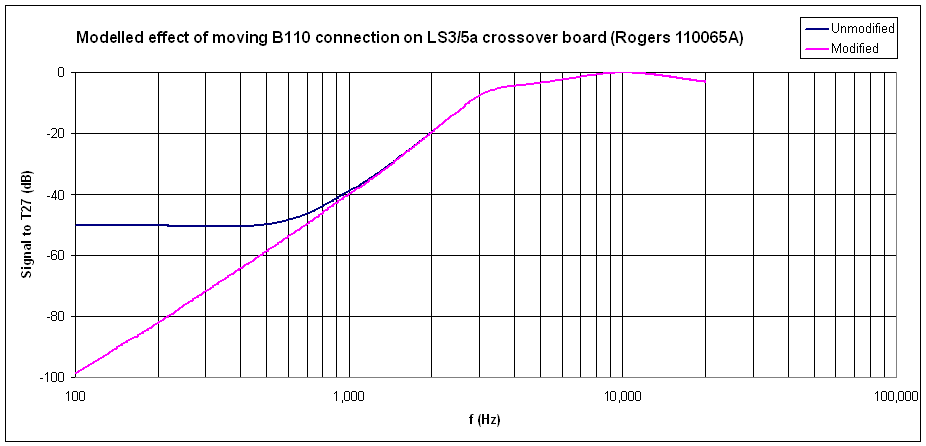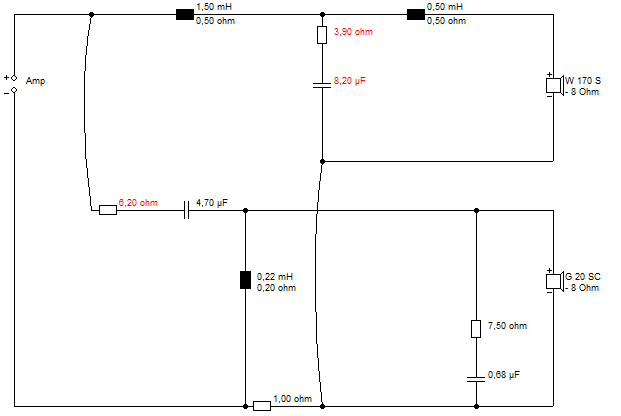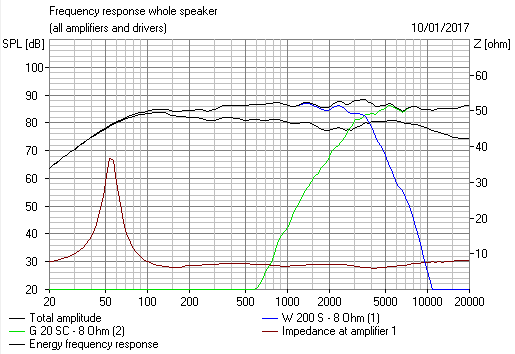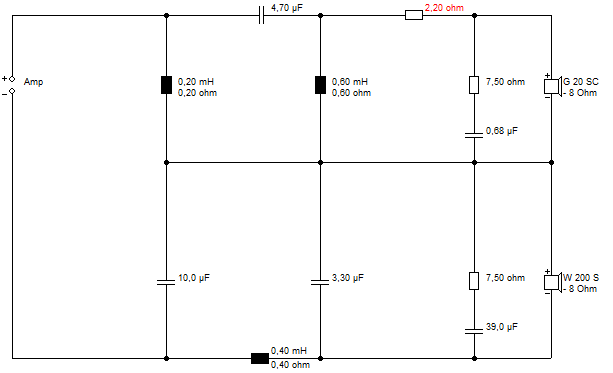No need for Religion to prove 2+2=4 , which is what "Technologists" claim.The 'golden ears' who don't succumb to the expectation effect of the 'emperor's new perfection' are quite used to being derided by pentecostal technologists.
Now for your beloved cr*p subjective statements, Faith is needed, plus conveniently shut eyes.
"Hey!!! I am more Technological than you!!! I mentioned FFT!!!" 😕
Right, you *mentioned* it ... at mumbo jumbo word level. 😀
Cuts less than a rubber knife unless you add some edge to it.
Like .... ummmmmm ..... "pentecostal" Math and graphs? 😛
It sells more wire.Take it or leave it on the merits of biwiring. 😀
Very true but that was a bonus. The dual terminals are for bi-amping, not bi-wiring. Bi-wiring is the result of an active imagination.I think a lot of manufacturers do it because it gives more room on the backplate of a speaker for bigger crossovers.
Must be a commercial speaker. Real men mount theirs to a board that is in turn mounted to the cabinet.This 4-element one is looking a bit squeezed onto a normal connector terminal plate:
I'd need to see what starquad does to know when to use it. Using it can't always make a difference. Also, there must be times when there are other ways to make the same changes.The results were the quatifying of degradations in the transfer function between amplifier and loudspeaker due to differences in loudspeaker cable construction. The perfect cable is no cable, however all cables have a measurable effect on the transfer function, and some cable constructions have much more effect than others.
Let's say that there was a difference, and it was resistance. The response changes, it isn't superior, just different.. and listeners have a preference. I could cut or lengthen any cable to change resistance, ergo concluding it is starquad has not solved the problem. The problem was simply EQ. Equalisation which was indicated by the two channel FFT.will normally give superior results
It is challenging resisting these threads on biwiring, so much misunderstanding.
I am up to that challenge..
Cheers,
John
I am up to that challenge..
Cheers,
John
Star quad speaker cable does not always make an obvious different. I think that complex or poor quality crossovers effectively decouple the drivers from the cable (and amplifier).
The greatest difference I have heard was with Bose 802 S2 PA speakers, in which in effect there is no crossover, simply 8 series drivers (although four drivers are bypassed above ~2kHz to prevent vertical beaming of the array and the need for excessive HF boost to overcome the series voice coil inductance). I discovered this during an annual checkup of about 40 cabinets on a theatre stage. Using a vocal microphone driven with the standard "check one two" test signal, an amplifier and a couple of speaker leads for expediency, and listening to someone else's voice from a few meters away in the auditorium some of the 802s seemed faulty and were put to one side for later testing. However the cabinets were just fine; one of the two speaker cables was 4-core wired star-quad, the other 2-core. Both leads were only 2-3m long! If I recall correctly (it was nearly 40 years ago) one lead was 2 x 14AWG and the other 4 x 16AWG, so about the same copper and return resistance in each cable. The 802 loudspeakers sounded unnatural and nasal on the 2-core cable and I can assure you that the difference was not subtle. The reference voice was there in person, so there was no doubts about which cable was "superior" either.
I was so excited at the time that I rewired the Tannoy Super Red Monitors in the Festival Centre's recording studio with star-quad. I was disappointed that it didn't seem to make any difference at all, despite them being much better speakers than the Bose. At the time I was of the school that all amplifiers sound the same, so maybe the cheap 1RU BGW amplifier we had in the studio was obfuscating change, or (I think more likely) the lossy iron-core inductors in the Tannoy crossovers effectively decoupled the drivers from benefiting from the amplifier's damping control, so the interconnection between the two (the cable) didn't matter as much.
Bose 802s were also used for the 'house system' at the time in the Festival Theatre, mounted on the proscenium walls. As a result of the discovery, we moved the house amplifier racks and mounted them on the proscenium wall behind the loudspeakers, with only a very short star-quad cable of about 1.5m through the wall to connect them. I can't tell you how many times we had complements like "I've never heard Bose sound that good" from international touring companies. The most memorable was in about 1986 from Julie Andrew's husband Blake Edwards, who was her producer for her international concert tours. Julie Andrew's technical rider specified Bose 802s for PA, so he wasn't unaccustomed to their sound. After her performance he nearly shook my hand off saying he had never heard Julie sound so good, and asked how did we get the 802s to sound like that? They'd been touring for years - why couldn't anyone else get that result from 802s?
These are the experiences that led me to jump at the chance to investigate further at Duntech, who could afford seriously expensive test equipment most audio guys only ever dreamt about. Duntech International PL was a defence technology company operating in Australia at the invitation of the government. it was founded by John Dunlavy, who also manufactured high end loudspeakers, the pinnacle being the Sovereign 2000.
Any change between the input and the output, whether response shaping or time domain aberrations, is clearly visible on the FFT when it subtracts the from output the input and shows the residual.
If two cables sound different difference it is entirely possible that one is superior. Why? Because a cable cannot improve the signal between the source and the receiver, only degrade it. If you have two cables of the same construction, one 5m long and on 10m, and if you can hear a difference between them, there can be no argument that the short one is superior, irrespective of what the difference might be caused by. This is a given because the short cable has ½ the degradation of the double length cable.
The greatest difference I have heard was with Bose 802 S2 PA speakers, in which in effect there is no crossover, simply 8 series drivers (although four drivers are bypassed above ~2kHz to prevent vertical beaming of the array and the need for excessive HF boost to overcome the series voice coil inductance). I discovered this during an annual checkup of about 40 cabinets on a theatre stage. Using a vocal microphone driven with the standard "check one two" test signal, an amplifier and a couple of speaker leads for expediency, and listening to someone else's voice from a few meters away in the auditorium some of the 802s seemed faulty and were put to one side for later testing. However the cabinets were just fine; one of the two speaker cables was 4-core wired star-quad, the other 2-core. Both leads were only 2-3m long! If I recall correctly (it was nearly 40 years ago) one lead was 2 x 14AWG and the other 4 x 16AWG, so about the same copper and return resistance in each cable. The 802 loudspeakers sounded unnatural and nasal on the 2-core cable and I can assure you that the difference was not subtle. The reference voice was there in person, so there was no doubts about which cable was "superior" either.
I was so excited at the time that I rewired the Tannoy Super Red Monitors in the Festival Centre's recording studio with star-quad. I was disappointed that it didn't seem to make any difference at all, despite them being much better speakers than the Bose. At the time I was of the school that all amplifiers sound the same, so maybe the cheap 1RU BGW amplifier we had in the studio was obfuscating change, or (I think more likely) the lossy iron-core inductors in the Tannoy crossovers effectively decoupled the drivers from benefiting from the amplifier's damping control, so the interconnection between the two (the cable) didn't matter as much.
Bose 802s were also used for the 'house system' at the time in the Festival Theatre, mounted on the proscenium walls. As a result of the discovery, we moved the house amplifier racks and mounted them on the proscenium wall behind the loudspeakers, with only a very short star-quad cable of about 1.5m through the wall to connect them. I can't tell you how many times we had complements like "I've never heard Bose sound that good" from international touring companies. The most memorable was in about 1986 from Julie Andrew's husband Blake Edwards, who was her producer for her international concert tours. Julie Andrew's technical rider specified Bose 802s for PA, so he wasn't unaccustomed to their sound. After her performance he nearly shook my hand off saying he had never heard Julie sound so good, and asked how did we get the 802s to sound like that? They'd been touring for years - why couldn't anyone else get that result from 802s?
These are the experiences that led me to jump at the chance to investigate further at Duntech, who could afford seriously expensive test equipment most audio guys only ever dreamt about. Duntech International PL was a defence technology company operating in Australia at the invitation of the government. it was founded by John Dunlavy, who also manufactured high end loudspeakers, the pinnacle being the Sovereign 2000.
Any change between the input and the output, whether response shaping or time domain aberrations, is clearly visible on the FFT when it subtracts the from output the input and shows the residual.
If two cables sound different difference it is entirely possible that one is superior. Why? Because a cable cannot improve the signal between the source and the receiver, only degrade it. If you have two cables of the same construction, one 5m long and on 10m, and if you can hear a difference between them, there can be no argument that the short one is superior, irrespective of what the difference might be caused by. This is a given because the short cable has ½ the degradation of the double length cable.
Last edited:
Bose 802s. Now there's how to destroy any credibility you might have, especially as you then wonder why it makes no difference in the more resolving LRMs (which I've owned). Hint; it's not audibly significant.
"If two cables sound different difference it is entirely possible that one is superior. Why? Because a cable cannot improve the signal between the source and the receiver, only degrade it."
Sure. But then you come to the fact that these purported differences are trivially easy to measure, yet never are, and given the theoretical that anything in the signal path potentially only degrades, we're back to the point of is it audibly significant, a position you have yet to in any way substantiate.
CHIC - Dance, Dance, Dance (Official Music Video) - YouTube
Bernard Edwards was great.
"If two cables sound different difference it is entirely possible that one is superior. Why? Because a cable cannot improve the signal between the source and the receiver, only degrade it."
Sure. But then you come to the fact that these purported differences are trivially easy to measure, yet never are, and given the theoretical that anything in the signal path potentially only degrades, we're back to the point of is it audibly significant, a position you have yet to in any way substantiate.
CHIC - Dance, Dance, Dance (Official Music Video) - YouTube
Bernard Edwards was great.
you then wonder why it makes no difference in the more resolving LRMs (which I've owned). Hint; it's not audibly significant.
The normal effect of star-quad cables for loudspeakers (when there is one) is a sense of improved bass extension and weight. With an A/B switch box to select between two cables, one 2-core, the other star-quad, I have clearly seen reduced driver cone excursion visible with star-quad cable, which might seem counter-intuitive given the sonic impression of more bass.
Unfortunately changing the cable didn't warm the LRMs in the studio as I described in the post above. Because of the control rooms dimensions there was a bass suck-out at the mix position which compounded the sound impression (it was latter corrected to some extent by traps).
A couple of years ago a colleague and former studio engineer who wasn't happy with the sound of his LRMs asked for my help. With a better amplifier there was a small but worthwhile improvement with star-quad cable in his room. Personally I thought the LRMs were still somewhat lean sounding.
Star-quad cables certainly make a worthwhile difference with my renovated Tannoy Ardens, but they have custom first order crossovers with, Zobel compensation on the bass driver and one additional tuning network to deal with the horn's fundamental resonance to allow for a first order high pass. The bass inductor has a DC resistance of 0.1000Ω and Q of 45.7 at crossover, measured on HP3456A meter and HP4192A Impedance Analyser respectively. The crossover alignment was derived from in situ impedance and response measurements using DATS and Omnimic.
Last edited:
No, it's a denial of basic physics, and/or, it's all a psychological artifact. If there was actually more bass, and less excursion, again, trivially easy to measure and then prove your assertion. However in 30+y, I've never seen a cable proponent, nor manufacturer do such a test, independently. Doing so would unequivocally prove your assertions true. The lack of such easily rendered evidence only shows me your claims have zero merit. In colloquial terms, they're crap. Put up or shut up, as they say.The normal effect of star-quad cables for loudspeakers (when there is one) is a sense of improved bass extension and weight. With an A/B switch box to select between two cables, one 2-core, the other star-quad, I have clearly seen reduced driver cone excursion visible with star-quad cable, which might seem counter-intuitive given the sonic impression of more bass.
I suspect no-one here would use 100m of 26AWG bell cord for a loudspeaker cable. What about 10m? Or 1m? At what point does inaudible cable degradation become audible? Can the boundary be specified at so many metres per cross-sectional area? Show me the DBLT and AES paper to prove where that point is.
I'm not denying basic physics. The equivalent circuit of an amplifier output / cable / loudspeaker with it many non-linear and parasitic effects is notoriously difficult to model with simple R/C/L networks. Cables also have the propensity to act like antennae and feed crap back into electronics with the potential to make circuits do strange things that affect sound. I guess everyone has heard a mobile phone breakthrough into an audio system.
As once technical journalist for Australia's live performance industry journal Connections (now called CX Network) I wrote a series about audio cables and pseudo-science in the Connections January, February and May 2000 editions. At the time I was working as Bassett Consulting Engineers' only Australian Electro-acoustic Engineer covering 5 offices in 4 states of Australia. Unfortunately whilst at least some of my articles are archived online the series on cable pseudo-science is not.
I'm not denying basic physics. The equivalent circuit of an amplifier output / cable / loudspeaker with it many non-linear and parasitic effects is notoriously difficult to model with simple R/C/L networks. Cables also have the propensity to act like antennae and feed crap back into electronics with the potential to make circuits do strange things that affect sound. I guess everyone has heard a mobile phone breakthrough into an audio system.
As once technical journalist for Australia's live performance industry journal Connections (now called CX Network) I wrote a series about audio cables and pseudo-science in the Connections January, February and May 2000 editions. At the time I was working as Bassett Consulting Engineers' only Australian Electro-acoustic Engineer covering 5 offices in 4 states of Australia. Unfortunately whilst at least some of my articles are archived online the series on cable pseudo-science is not.
can't find anything online....would be interested in those articles....i guess we have to take it at face value....
Here's an example where biwiring would have helped. But so would more competent earthing in a BBC LS3/5A... 🙄

Rogers LS3/5a 1100065A crossover PCB minor modification
Problem was the bass was dumping its return current onto the flimsy tweeter earth. And not at the input terminals. 😱
Models like this:

I'm sure it wouldn't have happened with star earthing. 😎
Rogers LS3/5a 1100065A crossover PCB minor modification
Problem was the bass was dumping its return current onto the flimsy tweeter earth. And not at the input terminals. 😱
Models like this:
I'm sure it wouldn't have happened with star earthing. 😎
Agree. That was the point of my post here: Bi-wire plus jumpersHere's an example where biwiring would have helped.
That's a design fault. Now show where and how biwiring is of benefit in correctly, ie competently designed and implemented systems.Here's an example where biwiring would have helped. But so would more competent earthing in a BBC LS3/5A... 🙄
Rogers LS3/5a 1100065A crossover PCB minor modification
Problem was the bass was dumping its return current onto the flimsy tweeter earth. And not at the input terminals. 😱
Models like this:
I'm sure it wouldn't have happened with star earthing. 😎
I never expressed a view about bi-wiring. Don't look at me. Nobody wins an argument.
But here's one of my own designs where it won't help:


Rather than worry about problems, I just sidestep them. Keeps me copacetic. 😎
But here's one of my own designs where it won't help:
Rather than worry about problems, I just sidestep them. Keeps me copacetic. 😎
^^ Sorry S7, it was a general question thrown out to the peanut gallery. Should have made that clear.
Whether the bi-wiring terminals were ever used for bi-wiring or not is irrelevant to the point I was making. I said that "One of the 'benefits' of bi-wiring terminals on a loudspeaker is that the layout of the crossover by necessity avoids poor circuit layout as far as common mode voltage drops between high and low outputs." I have never promoted bi-wiring to a single amplifier because it is a waste of copper IMO.That's a design fault. Now show where and how biwiring is of benefit in correctly, ie competently designed and implemented systems.
The LS3/5A is an example of sloppy crossover wiring. If it had been laid out to allow bi-wiring the design fault that "the bass was dumping its return current onto the flimsy tweeter earth" would have been eliminated, because the two sections of the crossover would have by necessity been separated - doh!
Where it is possible to assign multiple amplifier channels to L and R, such as some HT receivers, there may be a benefit for bi-wiring by masking limitations in the amplifiers. Buying a poor performing amplifier is not something I would recommend, but if there is a worthwhile improvement to be had in a given system why not do it?
Fair enough, but that's not how some of your earlier posts read.I have never promoted bi-wiring to a single amplifier because it is a waste of copper IMO.
Anything is possible, like me getting a pink unicorn, but I've yet to see any actual evidence this is true. Got some? Please post it, but leave out the anecdotes and theorising please.Where it is possible to assign multiple amplifier channels to L and R, such as some HT receivers, there may be a benefit for bi-wiring by masking limitations in the amplifiers.
Where? Not in this forum or any other.Fair enough, but that's not how some of your earlier posts read.
'pentecostal engineer'
I think that's what I am. I'm kind of proud of it too.
I can't help it. It's all the brainwashing I was subjected to at the universities I attended.
It's how I read them. I'll review again later when I have time.Where? Not in this forum or any other.
Ditto and I like the expression as well. Even more so were the engineers I worked with after college. I liked designing and building tube amps, still do, but I was still caught in the whole subjectivist thing, and they mocked me for it remorselessly, but not in a nasty way. It was to make me look, and approach things from different directions and I'm very grateful for it. I found out after the death of one that he was quite famous, but would have hated people to know, when his widow showed me his library, and his WWII commendations. Bless them.I think that's what I am. I'm kind of proud of it too.
I can't help it. It's all the brainwashing I was subjected to at the universities I attended.
- Home
- Loudspeakers
- Multi-Way
- Bi-wire plus jumpers